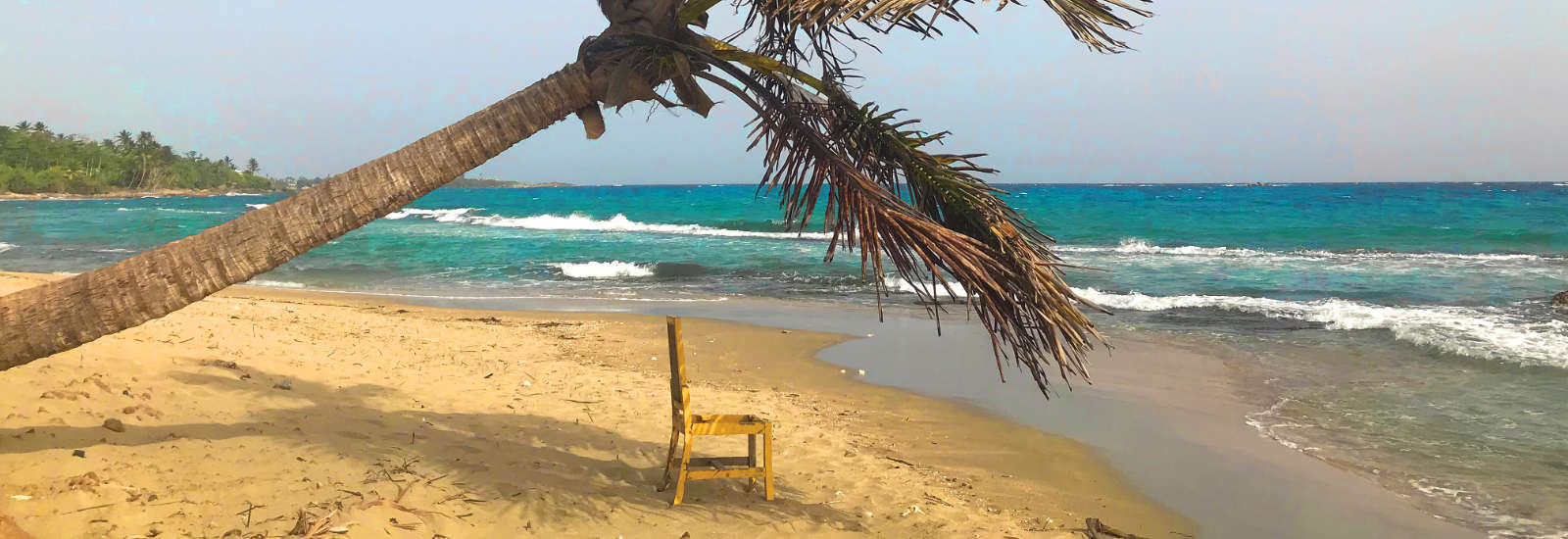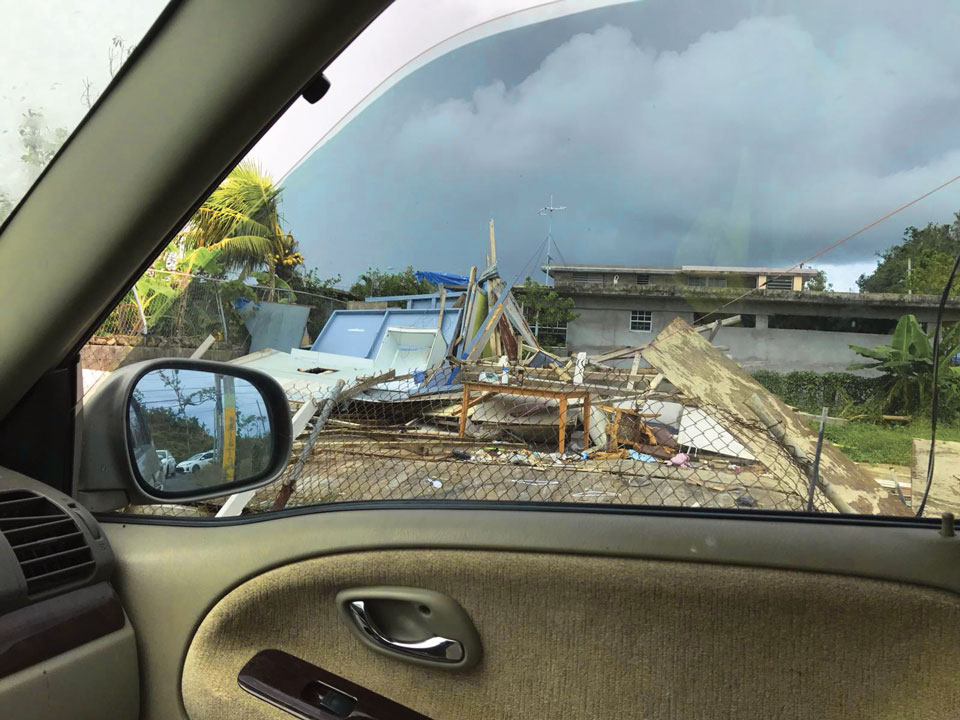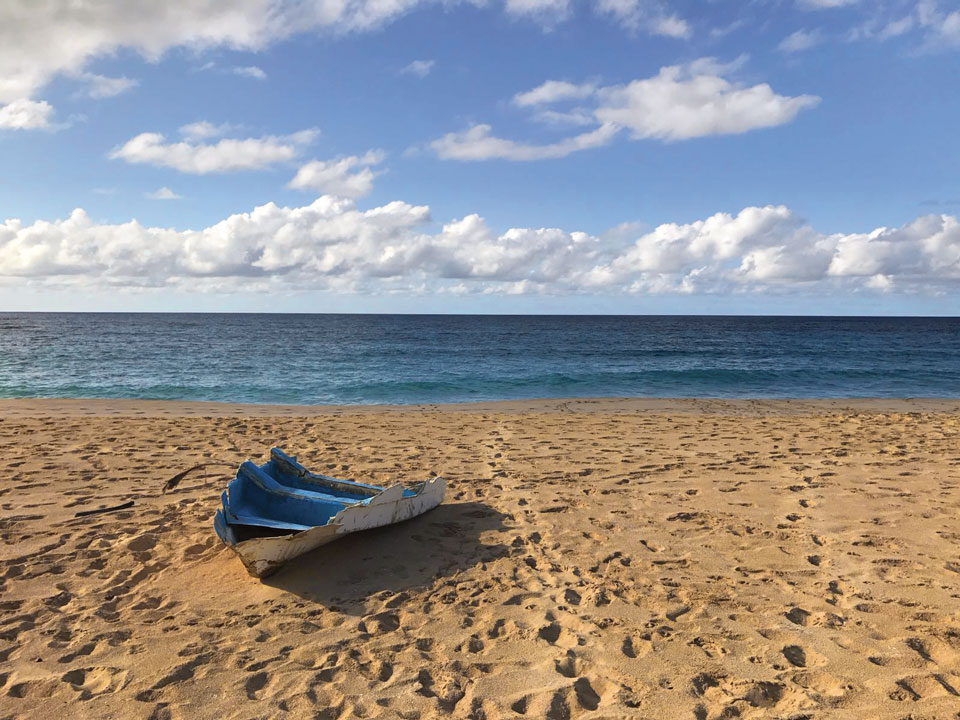The New Gastronome
Puerto Rico’s Peril
Reconstruction and Reformation for the Rich Port
by Allyson Perez
by Allyson Perez

There is a popular folk song in Puerto Rico called “Lamento Borincano” that tells the tale of a “Jíbaro,” or farmer, who is down on his luck. The Jíbaro takes his goods to sell in the big city, only to find that no one will buy from him. “What will happen to my Borinquén, dear Lord? What will happen to my children and to my home?” he cries, returning home sad and empty handed. However, this Jíbaro, patron representative of Puerto Rico, is determined not to give up. “I am a son of Borinquén, and no one can change that. The day I die, I will rest with you, my beloved Puerto Rico, and they cannot take that away from me!”
It’s no mistake that the symbol of the everyday Puerto Rican is the Jíbaro, the small farmer. Puerto Rico has a rich history of agriculture, albeit one that is quickly fading from memory. Various changes to the economy over the past several decades have seen to this, and the aftermath of Hurricane María last September all but solidified the fate of Puerto Rico’s food system to highly processed imports of low nutritional value. However, despite the obvious reasons for despair, there is hope yet for Puerto Rico’s food system to bounce back and to reinvent itself, to honor the farmers of yore and to encourage a new generation of Jíbaros.
It was evident after the storm cleared that Puerto Rico would not see anything resembling normalcy for a long time, with initial estimates of three to six months to renew access to electricity (the real wait time was much longer in many cases). However, it was not just the electrical grid that was hit heavy by the storm; Hurricane María left Puerto Rico’s already vulnerable food system in shambles. Immediately after the storm, Puerto Rican farmers were devastated by the losses in yield and resources for the year’s harvest; according to the New York Times, 80% of the crop value was wiped out by the storm.


To say that the Federal Emergency Management Agency’s (FEMA) response to the natural disaster was inadequate would be an understatement. The federal government’s rhetoric surrounding Puerto Rico matched its inadequate response, with President Trump insisting several times that Puerto Rico was hard to reach on account of it being “surrounded by big water” (not to mention his paper towel-tossing fiasco), and that its debt presented a problem in helping with disaster relief, despite the outpouring of support received in Houston, Texas after Hurricane Harvey only weeks before.
In fact, according to Politico, it took FEMA four times longer to approve permanent disaster work in Puerto Rico than it did in Texas, and nine days after the storm, Puerto Rico had received just 5 percent of the aid that Houston had received in the same amount of time. Further, FEMA contracted an Atlanta business that had no experience handling disaster relief, on top of a history of five cancelled federal contracts, to provide 30 million meals to be sent to Puerto Ricans in need, a contract worth a cool $156 million. In exchange for this comically large sum of money, The New York Times reported that Puerto Ricans received only 50,000 meals.
Where FEMA failed, charitable aid was able to pick up the slack, but only to a certain extent. Renowned Spanish chef José Andrés, owner of several restaurants around the world, including one in Dorado, Puerto Rico, did a tremendous job of providing good, nutritious meals to Puerto Ricans in the months after the hurricane and has been rightfully commended for his work. Not all the food aid received was of such high quality, however.
Food donated to Hurricane María relief was overwhelmingly processed and unhealthy, including items like candy and chips, according to NPR. As if this were not enough, several trailers filled with donated items, which included food and water, were found to have been rotting in a parking lot in the San Juan metro area for the past eleven months for reasons that are yet to have been determined, some littered with rat feces.
“Many factors are to blame for this debt crisis, including governmental corruption, but this is far from the only cause of the island’s doom.”
This Simpsons-esque disaster response would be funny if not for the fact that it led to thousands of deaths that could easily have been prevented. Initial estimates of the post-hurricane death toll stalled at 64 fatalities for months until a Harvard School of Public Health report stated in May that the death toll could be as high as 4,645, due to inadequate access to health care and other resources in the months following the hurricane.
In early July, the government of Puerto Rico quietly adjusted its own estimate to 1,427 in a preliminary report on recovery efforts, and on 28 August, Governor Ricardo Roselló announced that the official death toll pushed 3,000, at 2,975 deaths between when the hurricane hit in September 2017 and February 2018. Additionally, many Puerto Ricans fled the island after María out of fear for their own fates, the fates of their families, and frustration at the untenable quality of life that they faced by staying.
Puerto Rico in Crisis Long Before Hurricane Maria
Puerto Rico’s problems hardly began with Hurricane María. The island’s political and economic status have been precarious, at best, for decades; before María devastated the island physically, Puerto Rico was in the midst of grappling with a $123 billion dollar debt crisis that, as a US territory, it was not legally permitted to default on, resulting in the US Congress passing the PROMESA Act in the summer of 2016, which established an undemocratically-appointed Fiscal Control Board to oversee the island’s recovery.
The Fiscal Control Board has been at the helm of many unpopular measures before the hurricane, including the closure of 184 public schools and the closing of several of the 11 campuses and tuition hikes at the University of Puerto Rico. The latter proposal led to a months-long strike by UPR students that ended weeks before Hurricane María hit.
“It is this latter Jones Act along with Operation Bootstrap that, over the course of a century, turned Puerto Rico from an agricultural economy into a debt-ridden service economy.”
Many factors are to blame for this debt crisis, including governmental corruption, but this is far from the only cause of the island’s doom. Historical factors, especially ones that date back to the beginning of US involvement on the island, are also at play, and particularly affect the Puerto Rican food system. It took the United States 19 years after annexing Puerto Rico, in 1898, to grant Puerto Ricans US citizenship through the Jones Act of 1917, the first of two significant Jones Acts that have greatly impacted Puerto Rico.
The second Jones Act, also known as the Merchant Marine Act of 1920, made it so that any ship carrying goods to the United States could only dock in one US port, and that any ship sending goods to Puerto Rico had to be US made and have a majority-US crew. Later, starting under Governor Luis Muñoz Marín in the 1940s, Puerto Rico underwent Operation Bootstrap, which consisted of a series of economic reforms that pushed industrialization, driving farmers from the countryside into the cities, and from the cities to places like New York in the mainland United States. It is this latter Jones Act along with Operation Bootstrap that, over the course of a century, turned Puerto Rico from an agricultural economy into a debt-ridden service economy.
While the 1920 Jones Act’s intent was to bolster the US ship making industry, for Puerto Rico it has only added exorbitant costs to virtually everything bought and sold on the island. The Congressional Research Service has found that shipping goods to Puerto Rico in a way that’s compliant with the Jones Act costs twice as much as it does for normal international shipping. Ultimately, as noted by Vox’s Matthew Yglesias, this “raises the cost of living on Puerto Rico, makes Puerto Rico an unattractive place to produce goods bound for the US mainland, and has the bizarre effect of putting Puerto Rico at a competitive disadvantage to other Caribbean islands as a destination for tourists.”
Agriculture, Big Corp., and the Government
Agricultural production on the island has declined significantly, since the mid-20th century. Historically, sugar production was Puerto Rico’s main industry, but since 1964, the USDA has calculated that agricultural sales have declined by two thirds, and agricultural production has never been high enough to provide for the food needs of the island’s population. Even before María hit, the island imported 80% of its food, and food costs were twice as high in Puerto Rico as they are in Florida.
Now, after what was left of the agricultural industry was wiped out and access to food from the mainland became unstable as a result of the hurricane, Puerto Rico must have a serious reckoning with its food system to ensure that history doesn’t repeat itself when the next major hurricane inevitably hits (and with climate change, the question is not so much if another storm comes, but when).
“…rather than doling out the blame, the government of Puerto Rico must enact clear and guided policy towards creating an economy and a food system that support the Puerto Rican people financially and provide sustainable solutions for the many problems facing the island…”
Meanwhile, the Puerto Rican government has become a haven of corporate welfare for large companies and hedge funds, who rather than contribute to the Puerto Rican economy, have only increased the island’s $69 billion debt. Among the corporations who have taken advantage of these incentives, which included tax exemptions, wage subsidies, and industrial incentives, is Monsanto, which is just one of several producers of transgenic and hybrid seeds that benefitted from this policy.
This began under the governorship of Aníbal Acevedo Vilá, who served from 2005 to 2009, and Monsanto has continued operations on the island since then, despite refusing in 2013 to testify at Puerto Rican Senate hearings regarding their seed production and development operations in Puerto Rico.
Puerto Rico’s Economic Crisis and Possible Solutions
Puerto Rico was sitting on a time bomb that everyone knew would blow before the hurricane, but no one knew quite when. The bomb exploded last September when María hit, and now every aspect of the Puerto Rican economy—from the electrical grid to the educational system to the food system—has been hit by shrapnel from the detonated hodge-podge of catastrophic issues that has been accumulating for decades.
In the face of the many failures of his government since María hit, Governor Roselló has finally admitted blame for how poorly he handled the situation, but rather than doling out the blame, the government of Puerto Rico must enact clear and guided policy towards creating an economy and a food system that support the Puerto Rican people financially and provide sustainable solutions for the many problems facing the island, moving forward.
“…the government of Puerto Rico should create incentives for sustainable agriculture and food production on the island to feed its people.”
Puerto Rico can no longer rely on outside corporations coming in and taking advantage of the island’s resources for economic growth and the expansion of food options, because this predatory behavior is precisely what contributed to the debt crisis. Rather than creating incentives for outside hedge funds and corporations like Monsanto to set up shop on the island, the government of Puerto Rico should create incentives for sustainable agriculture and food production on the island to feed its people.
This may seem like a far-flung proposition, especially since Puerto Rico’s agricultural production levels have decreased significantly in recent decades, but it is not impossible. There are even models Puerto Rico can follow from its neighbors in the Caribbean and Puerto Rico in how to create systems of agroecological food production. Cuba, for example, has a long-standing history of promoting and subsidizing agroecological farming, a process that was necessitated after its own economic crisis after the fall of the Soviet Union in the 1990s.
By creating educational programs, subsidizing land access, and incentivizing research on agroecology, Cuba, in the past 25 years, has been able to create a burgeoning system of both small-and large-scale agroecology and agricultural collectives, which produce much of the fruits and vegetables consumed by Cubans across the country.
“…Puerto Rico already has a budding agroecological movement, with many small-scale farmers who were the only ones truly able to recover and thrive after the losses and devastation faced by conventional farmers across the island last September.”
In fact, Puerto Rico already has a budding agroecological movement, with many small-scale farmers who were the only ones truly able to recover and thrive after the losses and devastation faced by conventional farmers across the island last September. Producers like Ian Pagán Roig of El Josco Bravo farm in Toa Alta, who utilize agroecological methods on their farms, were able to bounce back from Hurricane María by taking cues from nature on how to respond to natural disasters—and with the frequency of both natural and man-made disasters on the island, this type of resilience is needed.
Pagán Roig is not alone in this work. Organizations such as San Juan’s el Departamento de la Comida, which, prior to María, was a vegetarian restaurant and since then has become a hub of organizing for change in Puerto Rico’s food system, are working to show their fellow Boricuas how farming and agroecology can produce tangible results in terms of food in mouths, and create resilience in the face of constantly changing economic and literal climates.
A Future of Sovereignty or Continued Strife?
The Puerto Rican food system and its economy, at large, is at a crucial juncture in its history. Regardless of the choices made in the coming months and years, the island’s future is by necessity going to have to depart from the model of unsustainable development that has been utilized over the course of the past 50 years. However, continuing to yield to outsiders and the interests of large corporations, represented by the current US Presidential Administration and the Fiscal Control Board, will only see further evisceration of the Puerto Rican economy, the continued exodus of Puerto Ricans from the island, and a complete inability for the island to feed or support itself, in any capacity.
“…Puerto Rico should push for the sovereignty and safety of its own people and look back on its pre-Commonwealth history as an agricultural producer for inspiration for a more sustainable future.”
Rather than make the current situation worse, Puerto Rico should push for the sovereignty and safety of its own people and look back on its pre-Commonwealth history as an agricultural producer for inspiration for a more sustainable future. Further, Puerto Rico should look to its neighbors like Cuba who have faced similar financial and environmental difficulties for guidance in how to implement agroecological reforms and promote sustainable agricultural systems.
Instead of consolidating the only center of agricultural and agroecological research at the Utuado Campus of the University of Puerto Rico into a smaller, regional campus as proposed by the Fiscal Control Board in March, funding and resources should be allocated towards expanding the Utuado campus’ agroecological research, in order to search for Puerto Rican solutions. Finally, young people who are already involved in the agroecological sector should be recognized and given incentives to expand their work across the island rather than ostracized.
In the face of the hardship created by the debt crisis and María, Puerto Rico has an opportunity to forge a new path for itself—not just a path of “rising,” as the recovery slogan “Puerto Rico se Levanta” suggests, but one of thriving. Striving towards agroecological reforms and self-sufficiency will help with this goal, but it will take bold leadership to recognize the benefits of these policies. Hopefully, Puerto Rico can channel the inner spirit of the resilient Jíbaro moving forward and guide its beloved Borinquén towards a future all of its children can benefit from.
Photos: ©2018 Jorge A. Méndez
References
4.https://www.cnn.com/2017/10/03/politics/donald-trump-paper-towels-puerto-rico/index.html
5.https://www.politico.com/story/2018/03/27/donald-trump-fema-hurricane-maria-response-480557
6.https://www.politico.com/story/2018/03/27/donald-trump-fema-hurricane-maria-response-480557
7.https://www.nytimes.com/2018/02/06/us/fema-contract-puerto-rico.html
8.https://www.nytimes.com/2017/10/30/dining/jose-andres-puerto-rico.html
10.https://www.cbsnews.com/news/puerto-rico-donated-supplies-expired-david-begnaud/
12.https://www.cnn.com/2018/08/28/health/puerto-rico-gw-report-excess-deaths/index.html
13.https://www.nytimes.com/interactive/2017/business/dealbook/puerto-rico-debt-bankruptcy.html
14.https://www.nbcnews.com/news/latino/here-s-how-promesa-aims-tackle-puerto-rico-s-debt-n601741
15.http://www.latimes.com/nation/nationnow/la-na-puerto-rico-bankruptcy-20170505-story.html
18.http://www.baltimoresun.com/news/opinion/oped/bs-ed-op-0316-puerto-rico-20180314-story.html
19.https://www.pbs.org/newshour/nation/jones-act-explained-waiving-means-puerto-rico
21.https://fas.org/sgp/crs/misc/R43653.pdf
22.https://www.vox.com/policy-and-politics/2017/9/27/16373484/jones-act-puerto-rico
24.https://palmer.house.gov/media-center/press-releases/forward-thinking-solution-puerto-rico
30.https://www.eater.com/2018/8/22/17761062/puerto-rico-hurricane-maria-recovery-fondo-de-resiliencia
31.http://www.upr.edu/wp-content/uploads/2018/03/UPR-Fiscal-Plan-21marzo2018.pdf